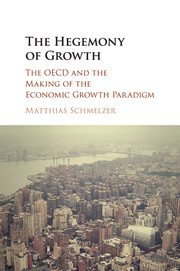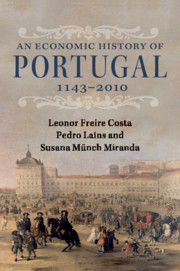Refine search
Actions for selected content:
26946 results in Economic history
Part I - Paradigm in the making
-
- Book:
- The Hegemony of Growth
- Published online:
- 05 May 2016
- Print publication:
- 17 May 2016, pp 75-162
-
- Chapter
- Export citation
Epilogue
-
- Book:
- The Hegemony of Growth
- Published online:
- 05 May 2016
- Print publication:
- 17 May 2016, pp 313-335
-
- Chapter
- Export citation
Introduction
-
- Book:
- The Hegemony of Growth
- Published online:
- 05 May 2016
- Print publication:
- 17 May 2016, pp 1-33
-
- Chapter
- Export citation
Index
-
- Book:
- The Hegemony of Growth
- Published online:
- 05 May 2016
- Print publication:
- 17 May 2016, pp 375-384
-
- Chapter
- Export citation
Setting the stage
-
- Book:
- The Hegemony of Growth
- Published online:
- 05 May 2016
- Print publication:
- 17 May 2016, pp 34-74
-
- Chapter
- Export citation
Figures and Tables
-
- Book:
- The Hegemony of Growth
- Published online:
- 05 May 2016
- Print publication:
- 17 May 2016, pp vii-vii
-
- Chapter
- Export citation
3 - “Expand or die”
- from Part I - Paradigm in the making
-
- Book:
- The Hegemony of Growth
- Published online:
- 05 May 2016
- Print publication:
- 17 May 2016, pp 142-162
-
- Chapter
- Export citation
9 - Quantifying quality
- from Part III - Paradigm in discussion
-
- Book:
- The Hegemony of Growth
- Published online:
- 05 May 2016
- Print publication:
- 17 May 2016, pp 288-312
-
- Chapter
- Export citation
8 - Reclaiming growth
- from Part III - Paradigm in discussion
-
- Book:
- The Hegemony of Growth
- Published online:
- 05 May 2016
- Print publication:
- 17 May 2016, pp 267-287
-
- Chapter
- Export citation
Glossary
-
- Book:
- The Hegemony of Growth
- Published online:
- 05 May 2016
- Print publication:
- 17 May 2016, pp xi-xii
-
- Chapter
- Export citation
4 - Power, progress, and prosperity
- from Part II - Paradigm at work
-
- Book:
- The Hegemony of Growth
- Published online:
- 05 May 2016
- Print publication:
- 17 May 2016, pp 167-188
-
- Chapter
- Export citation
The original Operation Twist: the War Finance Corporation's war bond purchases, 1918–1920
-
- Journal:
- Financial History Review / Volume 23 / Issue 1 / April 2016
- Published online by Cambridge University Press:
- 13 May 2016, pp. 21-46
-
- Article
-
- You have access
- HTML
- Export citation
FHR volume 23 issue 1 Cover and Back matter
-
- Journal:
- Financial History Review / Volume 23 / Issue 1 / April 2016
- Published online by Cambridge University Press:
- 13 May 2016, pp. b1-b3
-
- Article
-
- You have access
- Export citation
FHR volume 23 issue 1 Cover and Front matter
-
- Journal:
- Financial History Review / Volume 23 / Issue 1 / April 2016
- Published online by Cambridge University Press:
- 13 May 2016, pp. f1-f3
-
- Article
-
- You have access
- Export citation

Contractual Knowledge
- One Hundred Years of Legal Experimentation in Global Markets
-
- Published online:
- 05 May 2016
- Print publication:
- 26 May 2016

The Hegemony of Growth
- The OECD and the Making of the Economic Growth Paradigm
-
- Published online:
- 05 May 2016
- Print publication:
- 17 May 2016

An Economic History of Portugal, 1143–2010
-
- Published online:
- 05 May 2016
- Print publication:
- 03 May 2016
4 - The Atlantic economy, 1703–1807
-
- Book:
- An Economic History of Portugal, 1143–2010
- Published online:
- 05 May 2016
- Print publication:
- 03 May 2016, pp 164-227
-
- Chapter
- Export citation
1 - The medieval economy, 1143–1500
-
- Book:
- An Economic History of Portugal, 1143–2010
- Published online:
- 05 May 2016
- Print publication:
- 03 May 2016, pp 14-51
-
- Chapter
- Export citation
6 - Patterns of convergence, 1914–2010
-
- Book:
- An Economic History of Portugal, 1143–2010
- Published online:
- 05 May 2016
- Print publication:
- 03 May 2016, pp 291-344
-
- Chapter
- Export citation
